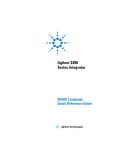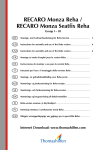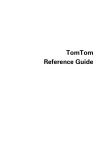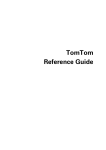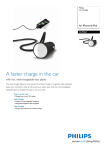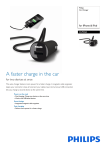Download OPERATING INSTRUCTIONS
Transcript
OPERATING INSTRUCTIONS MIETZSCH GmbH Lufttechnik Dresden Grossenhainer Str. 137 D- 01129 Dresden Phone (0351) 8433 129 Fax (0351) 8580 074 e-Mail [email protected] Internet http:/www.mietzsch.de Direct-driven radial fans Series VRE-W Belt-driven radial fans Series VRE-R Contents: 0. Preface to operating instructions 1. Fundamental safety instructions 1.1 1.2 1.3 1.4 Warning symbols Application as prescribed Organizational measures Remaining dangers 2. Transportation and storage 3. Assembly and starting 3.1 3.2 3.3 Instructions concerning electrical equipment Integrating the fan into the plant Initial starting 4. Operation and maintenance 5. Repair instructions 5.1 5.2 5.3 5.3.1 5.3.2 5.3.3 5.4 Cleaning VRE-W direct-driven fans VRE-R belt-driven fans Replacing the belt Replacing the motor Replacing flange and block-type bearings Working parts 6. Waste removal OI-VRE 05/02 1 0. Preface to operating instructions The present operating instructions are destined to make the users of fans of series VRE familiar with these devices so that they will be able to apply them as prescribed. The instructions contain important information for the reliable, appropriate, and economical use of these fans. Observation of such instructions helps to avoid danger and to reduce repair cost and downtimes. The operating instructions should permanently be available wherever the fan is applied. They have to be read and observed by everybody responsible for transportation, assembly, starting, maintenance, and repair of the fans. Approved technical regulations concerning workmanlike operation in consideration of safety prescriptions have to be observed in addition to the present operating instructions and valid legal directions for the prevention of accidents. 1. Fundamental safety instructions 1.1 Warning symbols ! Notes concerning economical use of the fan Details on prescriptions and prohibitions aiming at the prevention of personal injuries and material damages 1.2 Application as prescribed The fans are made on the basis of the state of the art and approved safety prescriptions. Their use, however, may imply danger to the user's life and limb and impairment of the machine and of other material values. This means that application as prescribed and technical reliability are of utmost importance. The users have to consider and observe the conditions specified hereinafter. Unless otherwise specified by contractual agreements, these conditions are as detailed in the manufacturers' prospectus valid at the making of contract. a. Demands on the conveying medium and on vicinity ! The permissible temperature range to be maintained depends on the fan type, speed rate, and material. Chemical resistivity of applied plastics to the conveying medium has to be tested. EX-type fans require the ignition temperature and area of explosion risk to be considered. Standard fans with EXtype motors have no general explosion protection. Mass density of the conveying medium has to correspond to that of pure air. The medium must not contain foreign particles and has to be practically dustless. Higher dustiness or impure gases with the tendency to deposit can be causes of damages. Condensate accumulating in the housing must be able to flow out without being inhibited. The fan must be arranged that it is free from shocks and vibrations, and it must not be subject to mechanical stress from outside. Check whether the fan is compatible with the environment. This refers above all to the temperature, chemical resistivity, and explosion risk. b. Demands on the operating mode ! The speed rate, speed rates or speed ranges for fan operation must not differ from those specified by the manufacturers. Series connection and parallel connection of fans with forward curved vanes (e.g.VRE / 734) and operation with higher or lower system pressure are impermissible without consultation with the manufacturers. Unless otherwise specified, the fan must be run in the specified characteristic range only. Fans with backward curved vanes (e.g.VRE / 731) permit operation beyond this range which, however, should be avoided for energetic reasons. To avoid escape of conveying medium through the shaft feedthrough, observe the condition suction side pressure loss 1 > total pressure loss 3 Special sealing measures should be subject to agreement with the manufacturers. Conditions for electrical connection of the electric motor must be observed. Speed setting and control are possible with no other fan types and control units than those permitted by the manufacturers. Nonobservance of the conditions specified above means violation of rules of application. The manufacturers cannot be held responsible for damages resulting from such nonobservance. OI-VRE 05/02 2 1.3 Organizational measures ! All operations with the fan must be carried through by those operators only who are well trained and reliable. Operation with electrical units (motors, control and regulating devices) must not be carried through but by qualified persons (see also DIN VDE 0105 or IEC 364). Repairs of explosion-proof fans must not be carried through but by the manufacturers or after consultation with them. Maintenance intervals have to be specified by the user in consideration of use conditions and, if needed, after consultation of the manufacturers. The fan must be thrown out of operation and repaired in cases of changes that might affect safety (such as uneven running, abnormal noise, damages and defects that are visible from outside). Original spare parts only have to be used for repair. Changes of the fan are impermissible if they lead to safety risks. The fan must not be thrown into operation unless its state is reliable. This means that all protective and safety systems (such as electrical motor protection, belt guard, in some cases protective gratings or strainers) have to be existing and functioning and that the fan has been integrated into the plant as indicated by the project. 1.4 Remaining dangers ! ! The fans are of reliable design. Their production is supervised by a quality monitoring system. A certain remaining danger, however, cannot be excluded. This can be caused e.g. by a broken runner, especially in case that the conditions of application (see Section 1.2) are violated. Consequently, the fan's vicinity must be secured so that persons and objects cannot be endangered in the case of a possible average. A strainer can avoid that housing destruction leads to danger to the vicinity by fragments, to be sure, but it is no absolute safety in cases of average. It cannot be excluded generally that small quantities of the conveying medium escape at the shaft feedthrough so that suitable safety measures should be taken according to dangerousness of the gas. The permissible immission limit for noise specified in relevant prescriptions for labour protection may be exceeded especially in cases of fans of larger power and arrangement in small and live rooms. Persons in such rooms must be protected by suitable measures from injuries by noise. 2. Transportation and storage Loading work has to be carried through by experienced persons only. Use hoisting means and load take-ups of sufficient load-carrying capacity. If transporting the fan take it by its steel components only. If transporting the fan by crane fasten suitable load take-ups to the base. Larger fans have two bores in their sheet metal base for fastening load take-ups. Transportation eyes of the motor must not be used for fan suspension. The fan must be transported in its working position (without vibration isolators put underneath) and protected reliably against getting out of place, tilting, and collision. If selecting means of transportation take care that plastic fans are susceptible to shocks. In the case of outdoor storage protect the motor and fan inside against direct atmospheric influence. 3. Assembly and starting 3.1 Instructions concerning electrical equipment The electrical equipment has to be installed by experts according to standards. Every motor has to be connected to the power supply system through a motor protection system. Bimetallic releases have to be set to rated current. In cases of pole-changing motors install either two separate motor protection switches or a thermal winding protection (PTC resistor --> special design TS). If the motor speed rate is controlled by voltage dividers or frequency inverters a conventional bimetallic switch offers incomplete motor protection only. A thermal motor protection (PTC resistor --> special design TS, thermocontacts) is necessary in that case. Also the protection by calculation of I²t, which is very often integreated in frequency inverters, can be used. Electrical connection has to be as shown in circuit diagrams in the terminal box or in the installed and wired repair switch. Check the data of electrical connection (voltage and frequency). Supply voltage in cases of star-delta switches must be the same as the lower voltage on the type plate. The fan must not be started before resistance of the winding relative to earth has been measured. Dry the winding if this resistance is less than 0.5 M . Check the direction of fan rotation by briefly starting it. It must coincide with the direction indicated by the arrow on the fan. After starting measure the current taken by the motor. OI-VRE 05/02 3 3.2 Integrating the fan into the plant Check the fan for transportation damages. Check and, if needed, ensure non-contacting rotation of the runner. Check the inside of the fan and of the plant connected. Remove all objects which may have been left behind. Take care of forgotten tools and residual material in particular. ! Check that all components before and behind the fan are functioning and fastened reliably (especially flaps and slides, but also vanes of elbow channels etc.) so that foreign bodies cannot run into the fan and destroy it. The fan has to be integrated into the plant as indicated by the project. If intakes are open to the vicinity guards or protective devices shall be fixed. Assembly requires even horizontal foundations or brackets whose stability has to be warranted by building work. The fan must principally be arranged on vibration isolators (included in delivery) and secured against getting out of place. Suction and pressure lines are connected by flexible pipes. Elements of the connected plant must not stress the fan mechanically. If needed, connect a line for condensate draining to the corresponding bore at the deepest part of housings. Motor cooling must not be impaired by adjacent components and walls. The distance between motor cooling air entrance and wall has to be at least half the motor size (such as distance of 40 mm for motor size 80). If arranged in open air the motor in particular has to be protected against direct atmospheric influences such as ice, snow, and hail (weather protecting sleeve in the accessories). 3.3 Initial starting Check before starting that the fan is used as prescribed (compare Section 1.2). The direct vicinity of the fan must be blocked to exclude danger to persons' life and limb and material values in the case of a possible destruction by transportation damages or foreign bodies. Proceed in the same way if the fan is switched on after a repair or longer downtime. Abnormal noise, uneven running, and excessive motor current often indicate fan defects which have to be eliminated without delay. Inform the manufacturers in cases of claims in the period of warranty. Unauthorized measures and changes void warranty. 4. Operation and maintenance Operate the fan that it can be run at any time according to safety regulations and as prescribed in Section 1. The fan has to be inspected regularly. The interval between two inspections depends on the corresponding application conditions. The minimum is an inspection every 5,000 service hours or once a year. The following items have to be checked during inspection: All electrical connections and the motor protection system Housing and base for visible damages Smooth running and noise (bearing noise, rubbing noise) Tension and wearing state of the belt Soiling of housing inside and motor Uneven running of the fan is often a clear indication of deposits on the runner. Check and clean immediately. The applied motors and flange bearings (belt driven fans VRE-R) usually are equipped with self-lubricating bearings. Their service life depending on operating conditions amounts to a maximum of 50,000 hours. Relubrication is thus not necessary. Motors and bearings (mainly block bearings) with lubrication nipples require relubrication with the grease prescribed after 5,000 to 12,000 hours with the grease prescribed (compare Section 5.4). Clean lubrication nipples. Turn rotor by hand. If an antifriction bearing is failing, replace this bearing or renew the motor or the complete bearing unit (see Repair instructions). OI-VRE 05/02 4 Checking the belt drive Belt-driven fans are supplied with the belt run in and pretensioned. If the fan is equipped with a belt tensioner, maintenance of the belt drive is restricted to a check of belt wear every 5,000 to 10,000 service hours depending on application. Belt drives without belt tensioner require belt tension to be checked every 5,000 to 8,000 service hours, again depending on application. Necessary setting values Fp (checking force) and te will be found in the Fan Identity Card. The belt is retensioned, if necessary, by setting of the motor sliding plate. It is checked by means of a predetermined checking force Fp which is applied to the middle of the load strand and has to deflect the belt from the straight by the amount te. Never forget to rearrange the belt guard before starting after maintenance. The fan has to be inspected thoroughly after about ten years. An expert has then to decide on its further use. 5. Repair instructions Any operation on the fan is impermissible unless it has been switched off. Make sure that it cannot be switched on during repair work. After repair proceed as in initial starting (Section 3.3). 5.1 Cleaning For cleaning the fan inside use the cleaning opening (in special accessories) or open the complete housing. Cleaning liquids must not damage the plastic components by partial dissolving. Never use hard objects for mechanical cleaning. 5.2 VRE-W direct-driven fans For motor exchange demount the fan into its main assemblies. Demounting Disconnect fan from power supply and take it out of the plant. Open suction socket (mark mounting position). Demount upper half of divided housing. Remove hub protecting cap (caps glued or welded on must be destroyed). Loosen hub securing fixture and pull off runner. Demount housing from base (not necessary in cases of divided housing). Demount motor and repair as specified in motor operating instructions or renew motor. Mounting Mounting is in reverse order. The following items must be considered: Use motor types only if the manufacturers have agreed. Reattach screw covers. Renew securing elements of hub connection. Renew hub protecting caps glued or welded on. Take care of mounting position of suction socket. OI-VRE 05/02 5 5.3 VRE-R belt-driven fans 5.3.1 Replacing the belt Worn belts must urgently be replaced by belts of the same type (as specified in Fan Identity Card). It is advisable to purchase spare belts from the MIETZSCH company. For replacing belts proceed as follows: Belt drive with motor sliding plate Demount belt guard loosen motor sliding plate Apply new belt Tension belt by shifting motor sliding plate Fasten motor sliding plate Check belt tension Fasten belt guard belt deflection te sliding plate check load Fp Belt drive with belt tensioner Demount belt guard. Loosen belt tensioner Loosen fastening screw of tension device Apply new belt. Tension belt by turning the fastening screw Fasten belt tensioner with base frame counter fastening screw Check belt tension Fasten belt guard belt deflection te tension pulley check load Fp tension pulley tensioner POLY-V - belt fastening screw of tension device motor tension lever with counter nut motor belt pulley base Check and, if needed, correct belt tension after running time of 30 to 60 minutes with full load. Changes of the belt drive, such as variation of transmission ratios, are permissible only after consultation with the MIETZSCH company since consequential damages will otherwise not be covered by warranty. 5.3.2 Replacing the motor Demounting Loosen belt (Section 5.3.1) Unscrew motor from base/sliding plate Demount driving belt pulley Mounting Fasten motor on base/sliding plate. Fasten driving belt pulley on motor shaft and align it exactly to driven pulley. Apply belt (Section 5.3.1). 5.3.3 Replacing flange and block-type bearings Loosen and apply belt (see Section 5.3.1) Replace bearing analogously to motor changing explained in Section 5.2. OI-VRE 05/02 6 5.4 Working parts Working parts are components which are degenerated during prescribed application and as expected have to renewed during the service live of the fan. Special data see delivery note, Fan Identity Card or label of motor (if necessary ask for information). Working parts VRE - W (direct driven): Working part is the motor (renew securing elements of hub connection and hub protection cap). Special data see delivery note, Fan Identity Card or label of motor. Working parts VRE - R (belt driven): Motor Belt Tensioner: tensioner Pulley (with axle an bearings) Flange bearing / block bearing bearings with lubrication nipples Grease type (unless otherwise specified ): SHELL Alvania R3, (ARAL Aralub HL 2, ESSO Beacon 2) amount of grease: 10 ... 20 g per bearing Lubrication interval (orientation for normal use) Fan size nenngröße VRE 100 ... 160 VRE 200 ... 250 VRE 315 ... 630 VRE 710 ... 1000 1000 12000 12000 10000 10000 Speed of impeller / 2000 3000 10000 10000 10000 9000 8000 7000 8000 - rpm 4000 8000 6000 5000 - 5000 7000 6000 - Special design GD (gastight casing) Working part is the sealing ring. It is recommended to renew the sealing ring if the bearing or motor will be exchanged. 6. Waste removal MIETZSCH-made fans are long-lived products. Consequently, waste removal is a problem occurring not earlier than many years after starting. According to present legal prescriptions, the single components are not regarded as hazardous waste. Metal components (base, motor, screws etc.) are scrapped as usual. Plastic components have to be cleaned and can then be treated as normal waste. Residual materials and deposits in the fan have to be removed by the user in consideration of conditions of environment control. OI-VRE 05/02 7 EG-Konformitätserklärung EC-Declaration of Conformity D MIETZSCH GmbH Lufttechnik Großenhainer Str. 137 - D 01129 Dresden GB MIETZSCH GmbH Lufttechnik Großenhainer Str. 137 - D 01129 Dresden EG-Konformitätserklärung im Sinne der EG-Maschinenrichtlinie EC-Declaration of Conformity as defined by the EC Council Direktive on Machinery Hiermit erklären wir, daß die nachfolgend bezeichnete Maschine aufgrund ihrer Konzipierung und Bauart sowie in der von uns in Verkehr gebrachten Ausführung den einschlägigen grundlegenden Sicherheitsund Gesundheitsanforderungen der EG-Maschinenrichtlinie entspricht. Bei einer nicht mit uns abgestimmten Änderung der Maschine verliert diese Erklärung ihre Gültigkeit. Herewith we declare that the machinery designated below, on the basis of its design and construction in the form brought onto the market by us is in accordance with the relevant safety and health requirements of the EC Council Directive on Machinery. If alterations are made to the machinery without prior consultations with us, this declaration becomes invalid Bezeichnung: Radialventilator Designation: Radial fan Maschinentyp: Baureihe VRE Machinery type: Series VRE Nenngröße 100 ... 1000 Size 100 ... 1000 Maschinen-Nr. / Baujahr: Siehe Typenschild Machinery -No. / Year of production : see rating plate Einschlägige EG-Richtlinien: Relevant EC Council Directives: EG-Maschinenrichtlinie (98/37/EG) EG-Niederspannungsrichtlinie (73/23/EWG, i.d.F. 93/68/EWG) EMV-Richtlinie 89/336/EWG Angewandte harmonisierte Normen, insbesondere: EC-Machinery Directive (98/37/EG) EC-Low Voltage Directive (73/23/EWG, i.d.F. 93/68/EWG) EMC-Guideline 89/336/EWG Applied harmonized standards, in particular: EN 292-1, EN 292-2 , EN 294 -Sicherheit von Maschinen EN 60204-1 Elektrische Ausrüstung von Maschinen EN 292-1, EN 292-2 , EN 294 -Safety of Machinery Für Ventilatoren in EX-Ausführung gelten zusätzlich: Europäische Richtlinie 94/9/EG (ATEX) EN 13463-1 und -5 Nichtelektrische Geräte für den Einsatz in explosionsgefährdeten Bereichen EN 50014, EN 50018, EN 50019 Elektrische Betriebsmittel für explosionsgefährdete Bereiche Explosion-proof Fans additionally apply to: European Directive 94/9/EG (ATEX) EN 13463-1 und -5 Non-electric equipment fo potentially explosive atmosphere EN 50014, EN 50018, EN 50019 Electrical apparatus for potentially explosive atmospheres Angewandte nationale Normen und technische Spezifikationen, insbesondere: VDMA 24167 Ventilatoren;Sicherheitsanforderungen VBG 5, VBG 5 DA Kraftbetriebene Arbeitsmittel Für Ventilatoren in EX-Ausführung gelten zusätzlich: VDMA 24169 Bauliche Explosionsschutzmaßnahmen an Ventilatoren Ex-RL Explosionsschutz-Regeln der Berufsgenossenschaft Chemie Dr. Wendt Geschäftsführer Dresden, den 16.06.2003 EN 60204-1 Electrical Equipment of Machines Applied national standards and technical specifications, in particular: VDMA 24167 Fans; Safety requirements VBG 5, VBG 5 DA Accident Prevention Regulations ´Power Driven Tools´ Explosion-proof Fans additionally apply to: VDMA 24169 Design related explosion protection measures for fans Ex-RL Code of Practice for Explosion Protection Dr. Wendt Manager Dresden, 16.06.2003 konf_vre MIETZSCH GmbH Lufttechnik Dresden Großenhainer Str. 137 01129 Dresden Fax (0351) 8 58 00 74 http://www.mietzsch.de








